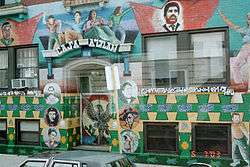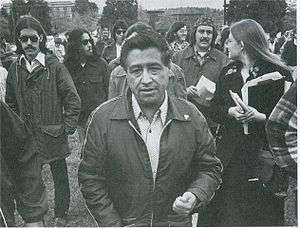Chicano Movement
| Chicano movement | |||
|---|---|---|---|
| Part of Chicanismo | |||
|
Cesar Chavez with demonstrators | |||
| Date | 1940s to 1970s | ||
| Location | Mainly the United States | ||
| Causes | Racism in the United States | ||
| Goals | Chicanismo | ||
| Methods | Occupations, Protest, Boycotts, School walkouts | ||
| Parties to the civil conflict | |||
| |||
| Lead figures | |||
|
| |||
The Chicano Movement of the 1960s, also called the Chicano Civil Rights Movement or El Movimiento, was a civil rights movement extending the Mexican American Civil Rights Movement of the 1960s with the stated goal of achieving Mexican American empowerment.
Origins
It encompassed a broad cross section of issues—from restoration of land grants, to farm workers' rights, to enhanced education, to voting and political rights, as well as emerging awareness of collective history. Socially, the Chicano Movement addressed negative ethnic stereotypes of Mexicans in mass media and the American consciousness. Edward J. Escobar sleeder from The Journal of American History describes some of the negativity of the time in stating, "The conflict between Chicanos and the LAPD thus helped Mexican Americans develop a new political consciousness that included a greater sense of ethnic solidarity, an acknowledgment of their subordinated status in American society, and a greater determination to act politically, and perhaps even violently, to end that subordination. While most people of Mexican descent still refused to call themselves Chicanos, many had come to adopt many of the principles intrinsic in the concept of chicanismo. Chicanos did this through the creation of works of literary and visual art that validated the Mexican American ethnicity and culture practices.
The term Chicanos was originally used as a derogatory label for the sons and daughters of Mexican migrants. Some prefer to spell the word "Chicano" as "Xicano". This new generation of Mexican Americans were singled out by people on both sides of the border in whose view these Mexican Americans were not "American", yet they were not "Mexican", either. In the 1960s "Chicano" was accepted as a symbol of self-determination and ethnic pride.
The Chicano Movement also addressed discrimination in public and private institutions. Early in the twentieth century, Mexican Americans formed organizations to protect themselves from discrimination. One of those organizations, the League of United Latin American Citizens, was formed in 1929 and remains active today.[1]
The Chicano Movement had been fermenting since the end of the U.S.–Mexican War in 1848, when the current U.S–Mexican border took form. Since that time, many Chicanos and Chicanas have campaigned against discrimination, racism and exploitation. The Chicano Movement that culminated in the early 1970s took inspiration from heroes and heroines from their indigenous, Mexican and American past.
The movement gained momentum after World War II when groups such as the American G.I. Forum (AGIF), which was formed by returning Mexican American veterans, joined in the efforts by other civil rights organizations.[2] The AGIF first received national exposure when it took on the cause of Felix Longoria, a Mexican American serviceman who was denied a funeral service in his hometown of Three Rivers, Texas after being killed during WWII.[3]
Mexican American civil rights activists also achieved several major legal victories including the 1947 Mendez v. Westminster Supreme Court ruling which declared that segregating children of "Mexican and Latin descent" was unconstitutional and the 1954 Hernandez v. Texas ruling which declared that Mexican Americans and other historically-subordinated groups in the United States were entitled to equal protection under the 14th Amendment of the U.S. Constitution.[4][5]
There were several leaders throughout the Chicano Movement. In New Mexico there was Reies López Tijerina who worked on the land grant movement. He fought to regain control of what he considered ancestral lands. He became involved in civil rights causes within six years and also became a cosponsor of the Poor People's March on Washington in 1967. In Texas, war veteran Dr. Hector P. Garcia founded the American GI Forum and was later appointed to the United States Commission on Civil Rights. In Denver, Rodolfo "Corky" Gonzáles helped define the meaning of being a Chicano through his poem Yo Soy Joaquin (I am Joaquin). In California, César Chávez and the farm workers turned to the struggle of urban youth, and created political awareness and participated in La Raza Unida Party.
The most prominent civil rights organization in the Mexican-American community is the Mexican American Legal Defense and Educational Fund (MALDEF), founded in 1968.[6] Although modeled after the NAACP Legal Defense and Educational Fund, MALDEF has also taken on many of the functions of other organizations, including political advocacy and training of local leaders.
Some women who worked for the Chicano movement felt that members were being too concerned with social issues that affected the Chicano community, instead of addressing problems that affected Chicana women specifically. This led Chicana women to form the Comisión Femenil Mexicana Nacional. In 1975, it became involved in the case Madrigal v. Quilligan, obtaining a moratorium on the compulsory sterilization of women and adoption of bilingual consent forms. These steps were necessary because many Hispanic women who did not understand English well were being sterilized in the United States at the time, without proper consent.[7][8]
With the widespread immigration marches which flourished throughout the U.S. in the Spring of 2006, the Chicano Movement has continued to expand in its focus and the number of people who are actively involved within the Mexican American community. As of the 21st Century, a major focus of the Chicano Movement has been to increase the (intelligent) representation of Chicanos in mainstream American media and entertainment.There are also many community education projects to educate Latinos about their voice and power like South Texas Voter Registration Project. SVREP's mission is to empower Latinos and other minorities by increasing their participation in the American democratic process. Members of the beginning of the Chicano movement like Faustino Erebia Jr., still speak about their trials and the changes they have seen over the years.[9][10]
Major cities
This is a list of the major epicenters of the Chicano Movement.
Political activism

In 1949 and 1950, the American G.I. Forum initiated local "pay your poll tax" drives to register Mexican American voters. Although they were unable to repeal the poll tax, their efforts did bring in new Hispanic voters who would begin to elect Latino representatives to the Texas House of Representatives and to Congress during the late 1950s and early 1960s.[11]
In California, a similar phenomenon took place. When World War II veteran Edward R. Roybal ran for a seat on the Los Angeles City Council, community activists established the Community Service Organization (CSO). The CSO was effective in registering 15,000 new voters in Latino neighborhoods. With this newfound support, Roybal was able to win the 1949 election race against the incumbent councilman and become the first Mexican American since 1886 to win a seat on the Los Angeles City Council.[12]
The Mexican American Political Association (MAPA), founded in Fresno, California came into being in 1959 and drew up a plan for direct electoral politics. MAPA soon became the primary political voice for the Mexican-American community of California.[13]
Student walkouts
After World War II, Chicanos began to assert their own views of their own history and status as Mexican Americans in the US and they began to critically analyze what they were being taught in public schools.[14]
In the late 1960s, when the student movement was active around the globe, the Chicano Movement inspired its own organized protests like the mass walkouts of high school students and the Chicano Moratorium in Los Angeles in 1970.[15] The student walkouts occurred in Denver and East LA of 1968. There were also many incidents of walkouts outside of the city of Los Angeles. In the LA County high schools of El Monte, Alhambra, and Covina (particularly Northview) the students marched to fight for their rights. Similar walkouts took place in 1978 of Houston high schools to protest the discrepant academic quality for Latino students. There were also several student sit-ins as objection to the decreasing funding of Chicano courses.
The blowouts of the 1960s can be compared to the 2006 walkouts, which were done as opposition to the Illegal Immigration Control bill.
Student and youth organizations
Chicano student groups such as United Mexican American Students (UMAS), Mexican American Youth Association (MAYA) in California, and the Mexican American Youth Organization (MAYO) in Texas, developed in universities and colleges in the mid-1960s. South Texas had a local chapter of MAYO that also made significant changes to the racial tension in this area at the time. Members included Faustino Erebia Jr, local politician and activist, who has been a keynote speaker at Texas A&M University at the annual Cesar Chavez walk.[16][17] At the historic meeting at the University of California, Santa Barbara in April 1969, the diverse student organizations came together under the new name Movimiento Estudiantil Chicano de Aztlán (MECHA). Student groups such as these were initially concerned with education issues, but their activities evolved to participation in political campaigns and to various forms of protest against broader issues such as police brutality and the U.S. war in Southeast Asia.[17] The Brown Berets, a youth group which began in California, took on a more militant and nationalistic ideology.[18]
Anti-war activism
The Chicano Moratorium was a movement by Chicano activists that organized anti-Vietnam War demonstrations and activities throughout the Southwest and other Mexican American communities from November 1969 through August 1971. The movement focused on the disproportionately high death rate of Mexican American soldiers in Vietnam as well as discrimination faced at home.[19] After months of demonstrations and conferences, it was decided to hold a National Chicano Moratorium against the war on August 29, 1970. The march began at Belvedere Park in LA and headed towards Laguna Park (since renamed Ruben F. Salazar Park) alongside 20,000 to 30,000 people. The Committee members included Rosalio Munoz and Corky Gonzales and only lasted one more year but the political momentum generated by the Moratorium led many of its activists to continue their activism in other groups.[20]
Chicano art
Art of the Movement was the burgeoning of Chicano art fueled by heightened political activism and energized cultural pride. Chicano visual art, music, literature, dance, theater and other forms of expression have flourished. During the 20th century, an emergence of Chicano expression developed into a full-scale Chicano Art Movement. Chicanos developed a wealth of cultural expression through such media as painting, drawing, sculpture and printmaking. Similarly, novels, poetry, short stories, essays and plays have flowed from the pens of contemporary Chicano writers. Chicano, Mexican-American, and Hispanic cultural centers, theaters, film festivals, museums, galleries and numerous other arts and cultural organizations have also grown in number and impact since this time.
Chicano Art developed around the 1960s.[21] In its beginning stages, Chicano art was distinguished by the expression through public art forms. Chicano artists created a bi-cultural style that included US and Mexican influences. The Mexican style can be found by their use of bright colors and expressionism. The art has a very powerful regionalist factor that influences its work. Examples of Chicano muralism can be found in California at the historic Estrada Courts Housing Projects in Boyle Heights.[22] Another example is La Marcha Por La Humanidad, which is housed at the University of Houston.
About 20 years later, Chicano artists were affected by political priorities and societal values. They were also becoming more accepted by society. They were becoming more interested making pieces for the museums and such, which brought about new forms of artwork, like easel paintings. By the late 1970s, women became very prominent in the artistic world. An increase in individualism was more apparent as Chicano artists entered the art business market.
Aztlán
(Taken from the Chicano Activism section of the main article Aztlán)
The concept of Aztlán as the place of origin of the pre-Columbian Mexican civilization has become a symbol for various Mexican nationalist and indigenous movements.
The name Aztlán was first taken up by a group of Chicano independence activists led by Oscar Zeta Acosta during the Chicano movement of the 1960s and 1970s. They used the name "Aztlán" to refer to the lands of Northern Mexico that were annexed by the United States as a result of the Mexican-American War. Combined with the claim of some historical linguists and anthropologists that the original homeland of the Aztecan peoples was located in the southwestern United States even though these lands were historically the homeland of many American Indian tribes (e.g. Navajo, Hopi, Apache, Comanche, Shoshone, Mojave, Zuni and many others). Aztlán in this sense became a "symbol" for mestizo activists who believed they have a legal and primordial right to the land, although this is disputed by many of the American Indian tribes currently living on the lands they claim as their historical homeland. Some scholars argue that Aztlan was located within Mexico proper. Groups who have used the name "Aztlán" in this manner include Plan Espiritual de Aztlán, MEChA (Movimiento Estudiantil Chicano de Aztlán, "Chicano Student Movement of Aztlán").
Many in the Chicano Movement attribute poet Alurista for popularizing the term Aztlán in a poem presented during the Chicano Youth Liberation Conference in Denver, Colorado, March 1969.[23]
See also
- Mestizos in the United States
- Chicano
- Chicanismo
- Chicano nationalism
- Chicano studies
- Chicano/a Movement in Washington State History Project
Notes
- ↑ "LULAC: LULAC History - All for One and One for All". Retrieved 23 September 2015.
- ↑ "毎月の返済が遅れるなどを - お金を借りる即日cash|ブラックでもお金借りたい方必見". Archived from the original on 6 July 2015. Retrieved 23 September 2015.
- ↑ Williams, Rudi. "Congress Lauds American G.I. Forum Founder Garcia". U.S. Department of Defense. Archived from the original on 2012-04-14.
- ↑ "LatinoLA - Hollywood :: Mendez v. Westminster". LatinoLA. Retrieved 23 September 2015.
- ↑ HERNANDEZ v. TEXAS. The Oyez Project at IIT Chicago-Kent College of Law. http://www.oyez.org/cases/1950-1959/1953/1953_406/
- ↑ MALDEF - About Us Archived April 22, 2008, at the Wayback Machine.
- ↑ "STERILIZED in the Name of Public Health". PubMed Central (PMC). Retrieved 23 September 2015.
- ↑ "Untitled Document". Retrieved 23 September 2015.
- ↑ "Archived copy". Archived from the original on 2012-03-06. Retrieved 2013-02-01.
- ↑ "Chicano Power in the U.S.A." - Xcano Media, Los Angeles
- ↑ ""Our First Poll Tax Drive": The American G.I. Forum Fights Disenfranchisement of Mexican Americans in Texas". Retrieved 23 September 2015.
- ↑ "Election of Roybal, democracy at work : extension of remarks of Hon. Chet Holifield of California in the House of Representatives". Retrieved 23 September 2015.
- ↑ "Untitled Document". Retrieved 23 September 2015.
- ↑ "Archived copy". Archived from the original on 2009-06-27. Retrieved 2009-06-27.
- ↑ Our PLACE Called Home - The Chicano Student Walkout Archived May 10, 2011, at the Wayback Machine.
- ↑ http://www.tamuk.edu/southtexan/PDF_Archives/032310.pdf
- 1 2 Moore, J. W., & Cuéllar, A. B. (1970). Mexican Americans. Ethnic groups in American life series. Englewood, Cliffs, N.J.: Prentice-Hall. p. 150. ISBN 0-13-579490-0
- ↑ Moore, J. W., & Cuéllar, A. B. (1970). Mexican Americans. Ethnic groups in American life series. Englewood, Cliffs, N.J.: Prentice-Hall. p. 151. ISBN 0-13-579490-0
- ↑ "30 Years After the Chicano Moratorium". Frontlines of Revolutionary Struggle. Retrieved 23 September 2015.
- ↑ http://chicanomoratorium.org/html/history_timeline.html
- ↑ Goldman, Shifra M. "Latin American artists of the USA". Oxford Art Online. Retrieved 20 April 2012.
- ↑ "Estrada Courts".
- ↑ "Alurista Essay - Critical Essays". eNotes. Retrieved 23 September 2015.
Further reading
- Gómez-Quiñones, Juan, and Irene Vásquez. Making Aztlán: Ideology and Culture of the Chicana and Chicano Movement, 1966-1977 (2014)
- Meier, Matt S., and Margo Gutiérrez. Encyclopedia of the Mexican American civil rights movement (Greenwood 2000) online
- Orozco, Cynthia E. No Mexicans, women, or dogs allowed: The rise of the Mexican American civil rights movement (University of Texas Press, 2010) online
- Rosales, F. Arturo. Chicano! The history of the Mexican American civil rights movement (Arte Público Press, 1997); online
- Sánchez, George I. "Ideology, and Whiteness in the Making of the Mexican American Civil Rights Movement, 1930–1960" Journal of Southern History (2006) 72#3 pp. 569–604 in JSTOR
External links
- "La Batalla Está Aquí": The Chicana/o Movement in Los Angeles, interview series, Center for Oral History Research, UCLA Library Special Collections, University of California, Los Angeles.
- Mexican-American.org – Network of the Mexican American Community
- NetworkAztlan.com - Network Aztlan
- Chicana community search page

